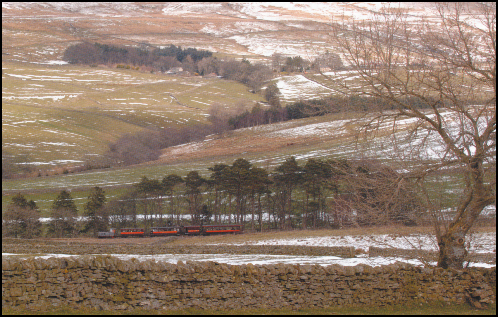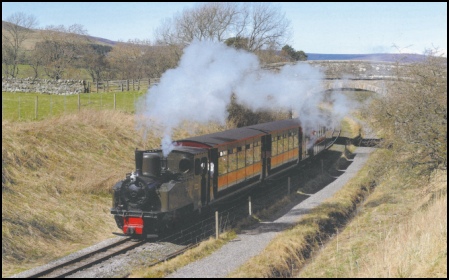



Go to South Tynedale Preservation Society Web-
The South Tynedale Railway
The South Tynedale Railway is a narrow gauge railway, built to British two feet gauge or 610 mm metric equivalent, which runs from Alston in Cumbria, northwards into Northumberland, in Northern England. It has been constructed by volunteers on the formation of a former standard gauge branch line from the historic Newcastle and Carlisle Railway.
Photo: Helen Kathryn and Thomas Edmondson double head an Alston bound train. Photo: Dave Hewitt.
Two hundred years ago, Alston was the commercial centre of an important lead mining area, producing about 10,000 tonnes of lead per year. On 26th August 1846, the Newcastle and Carlisle Railway Company obtained an Act of Parliament, allowing it to build a branch line, 27 kilometres long, to the lead mines of the North Pennines at Nenthead.
On 13th July 1849, a second Act was obtained allowing the Company to abandon the very steep section of 6.4 kilometres from Alston to Nenthead, and to improve the alignment between Alston and the Newcastle and Carlisle main line at Haltwhistle. The construction then proceeded rapidly and the line was opened in sections, between March 1851 and 17th November 1852. The plans for the line showed three viaducts over the River South Tyne and seven embankments over its tributaries. In the north, the contractors followed the plans reasonably carefully, constructing one viaduct and two embankments, but to the south, different contractors replaced five embankments by five viaducts and altered the gradient of the line, so that a ninth viaduct was required. The branch line served the communities of the South Tyne Valley for 126 years, until it was closed completely on 1st May 1976.
On 13th July 1849, a second Act was obtained allowing the Company to abandon the very steep section of 6.4 kilometres from Alston to Nenthead, and to improve the alignment between Alston and the Newcastle and Carlisle main line at Haltwhistle. The construction then proceeded rapidly and the line was opened in sections, between March 1851 and 17th November 1852. The plans for the line showed three viaducts over the River South Tyne and seven embankments over its tributaries. In the north, the contractors followed the plans reasonably carefully, constructing one viaduct and two embankments, but to the south, different contractors replaced five embankments by five viaducts and altered the gradient of the line, so that a ninth viaduct was required. The branch line served the communities of the South Tyne Valley for 126 years, until it was closed completely on 1st May 1976.
Following the announcement in 1973, that the Haltwhistle to Alston branch line was to close three years later, the South Tynedale Railway Preservation Society was formed. The original intention was to purchase the entire line, but this plan failed and the standard gauge track was rapidly lifted.
On 2nd July 1977, the members of the Society decided to build a narrow gauge line along part of the old formation and reached agreements with Northumberland and Cumbria County Councils who had purchased the trackbed. Passenger trains started running on 30th July 1983 to a temporary terminus, named Gilderdale Halt, about one mile north of Alston. The Society has permission to extend the line to Slaggyford village in Northumberland and has opened three extensions, on 12th December 1986, 4th September 1999 and 1st April 2012. Today the line is 31/2 miles or 5.5 kilometres long, with trains terminating in Northumberland at the new station of Lintley.
When work started on rebuilding the railway, the Society did not possess any workshops or buildings, in which to store the locomotives
On 2nd July 1977, the members of the Society decided to build a narrow gauge line along part of the old formation and reached agreements with Northumberland and Cumbria County Councils who had purchased the trackbed. Passenger trains started running on 30th July 1983 to a temporary terminus, named Gilderdale Halt, about one mile north of Alston. The Society has permission to extend the line to Slaggyford village in Northumberland and has opened three extensions, on 12th December 1986, 4th September 1999 and 1st April 2012. Today the line is 31/2 miles or 5.5 kilometres long, with trains terminating in Northumberland at the new station of Lintley.
When work started on rebuilding the railway, the Society did not possess any workshops or buildings, in which to store the locomotives
Mission Statement for the South Tynedale Railway:-
“To provide satisfaction for our customers and volunteers by operating a friendly, safe and efficient narrow-gauge railway.”
“To provide satisfaction for our customers and volunteers by operating a friendly, safe and efficient narrow-


Photo: Thomas Edmondson heads a train back to Alston on a sunny Spring day in 2009. Photo: Dave Hewitt.
and carriages, but at the beginning of 1984, the volunteers started to construct a building to house the locomotives. Now, the Society owns three buildings in which the volunteers can undertake the complete rebuilding of all rolling stock and to store the majority of the vehicles.
The passenger service commences at Easter and trains run every weekend, bank and most school holidays until the end of October. Steam locomotives are used on trains on most Sundays in June and July and daily from the last week in July to the end of August. Special events for families and children, with steam locomotives in service, are run in May, June and October. Special steam trains with gifts for children and seasonal refreshments for adults are run in December, before Christmas.